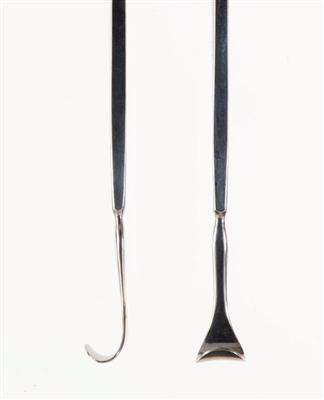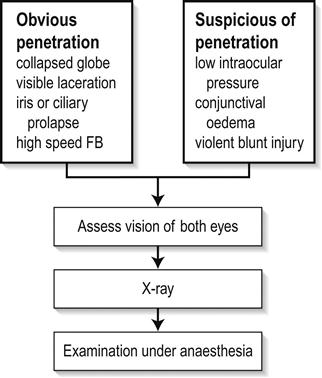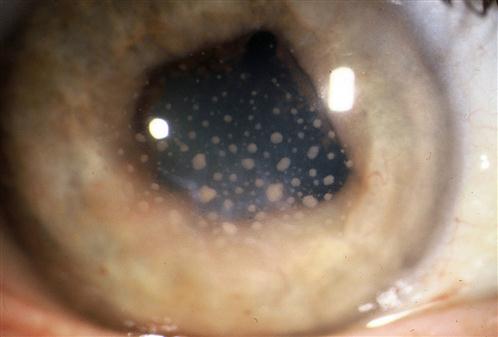Edited by Peter Cameron David V Kaufman, James K Galbraith and Mark J Walland Acute ocular presentations are common. A seemingly trivial trauma may mask a more serious underlying injury. Similarly, a relatively transient episode of visual loss with no abnormality found on examination may indicate potentially life-threatening cerebrovascular disease. Therefore, all eye presentations in an emergency department (ED) should be carefully evaluated with the necessary equipment. Basic sight testing equipment should include a Snellen 6-metre chart and a black occlusive paddle with multiple pinhole perforations. A slit-lamp biomicroscope is needed for examination of the anterior segment and the removal of foreign bodies. A portable slit lamp for examining reclining patients can be a valuable asset in the emergency department. An intraocular pressure-measuring device, such as a Tono-pen or iCare tonometer which is portable, accurate and easily used, is desirable. The incidence of injuries varies with the environment and protective measures taken. The major injuries result from blunt trauma or penetrating injuries to the globe, with or without the retention of a foreign body. Mechanical interference with eye movement may result from orbital injury, either haematoma or interference with muscle function. Similarly, neurotrauma may disturb the visual pathways or ocular motor nerves. It is necessary to elicit a history of the patient’s prior visual status, including the wearing of glasses or contact lenses and ocular medication. After an eye toilet to remove any debris from the eyelids, vision is tested by a distance Snellen chart, if necessary using a pinhole device as a rough focussing aid. Vision less than 6/60 Snellen may be graded by the patient’s ability to count fingers (CF) at a measured distance, discern hand movements (HM) or to project the direction of a light (PL) from various angles. The eye not being tested must be completely shielded by an opaque occluder. It is essential to assess early whether the patient has sustained a relatively minor superficial injury or a severe injury, which may be either blunt or penetrating. Reassurance and extreme gentleness in examining the eye will allow a more definite assessment to be made in the ED. Fresh local anaesthetic drops–preferably single use Minims – may be instilled to ease discomfort. With penetrating trauma, any external pressure on the eye may result in ocular structures being squeezed out of the wound, drastically worsening the prognosis. Desmarres retractors (Fig. 16.1.1) can be useful to open the lids yet avoid globe pressure. To open lids that are adherent due to blood or discharge, gently bathe with sterile saline. Wipe the eyelid skin dry and apply gentle distractive pressure to skin below the brow and below the lower lid, i.e. over bony orbital rim to open the lids. All patients in whom a penetrating injury is suspected require X-ray or computed tomography (CT) scanning to exclude a radiopaque intraocular foreign body (IOFB). If there is any possibility of metallic IOFB, magnetic resonance imaging (MRI) scans are contraindicated. When an adequate examination cannot be made, or where occult perforation is suspected, examination under anaesthesia is mandatory. The corneal epithelium is easily dislodged by a glancing blow from fingers, twigs, stones or a paper edge. The trauma produces an acute sensation of a foreign body, with light sensitivity and excessive tearing. After fluorescein staining, the size of the epithelial defect is recorded. Antibiotic ointment (chloramphenicol) is instilled and an eye pad applied if local anaesthetic was used. The condition heals spontaneously within 24–48 h. Large abrasions produce reflex ciliary spasm, which may require short-acting mydriatics, such as homatropine 2%, in addition to oral analgesia to relieve the pain. Under no circumstances can a patient ever be discharged with local anaesthetic drops for their own use. Small ferrous particles rapidly oxidize when adherent to the corneal epithelium, producing a surrounding rust ring within hours. The rusted particle requires removal under adequate topical anaesthesia using a slit-lamp microscope. An adherent rust ring may be loosened by the application of antibiotic ointment and padding for 24 h, after which it is easily shelled out with the edge of a fine hypodermic needle. Mechanical dental burrs can be difficult to sterilize and may cause large areas of epithelial removal and delay return to work. Wooden splinters are particularly dangerous as they may easily penetrate the eye and cause violent suppuration. In all suspected foreign body injuries, the upper and lower lids should be everted and examined with suitable lighting and magnification. The conjunctival fornices may be swept gently with a moist cotton bud under topical anaesthesia. Technique for upper eyelid eversion: the patient must look down at all times; grasp the upper lid lashes and draw the lid down, then with a cotton bud in the other hand, depress the lid 11 mm above the central lid margin (i.e. above the tarsal plate) and counter-rotate the grasped lashes and lid around this cotton-bud fulcrum. The lashes may be held against the superior orbital margin with a finger and the cotton bud removed. When the examination is complete, release the lid and allow the patient finally to look up and the lid will revert to the normal position. Unless large, it is rare that these require suturing. It is, however, vital to ensure that this superficial laceration does not hide a deeper penetration of the globe. After instillation of local anaesthetic, the conjunctiva may be gently moved aside with a cotton bud to examine the bed of the laceration. A careful history is important in assessing penetrating injury, including prior visual status and the use of contact lenses or spectacles. Occupational trauma may be due to high-speed penetrating metal fragments. Agricultural trauma often involves heavily contaminated implements. Australian seatbelt legislation has markedly reduced the incidence of penetrating eye injuries in road trauma, but eye problems still occur from violent head and facial trauma, in addition to the neurological complications of head injury [1,2]. Examination of the eye involves the instillation of sterile topical anaesthetic drops, followed by a gentle eye toilet removing debris, clot and glass from the face and lids. The lids should be opened without pressure (Fig. 16.1.2). The penetration may be evidenced by an obvious laceration or presence of prolapsed tissue with collapse of the globe. Conjunctival oedema (chemosis) and low intraocular pressure (IOP) may indicate an occult perforation or bursting injury. When a penetrating injury is either suspected or established, the patient must be transferred without delay to a centre where appropriate surgical facilities are available. During transport, the eye should be covered with a sterile pad and a plastic cone. Vomiting should be prevented with antiemetics and the fasted patient given intravenous fluids as necessary. Extruded tissue or projectiles should not be removed: intraocular contents will surely follow. Removal can only be undertaken in the controlled environment of an operating theatre. Prognosis depends on the extent of globe disruption. Concussion of the globe may cause tearing of the iris root, resulting in blood in the anterior chamber (hyphaema). A hyphaema greater than one-third of the anterior chamber usually indicates some damage to the drainage angle and may also be associated with concussive lens damage. Uninterrupted absorption of the hyphaema is essential and is aided by sedation and an admission to hospital. Traditional treatment is to pad the affected eye and to nurse the patient semirecumbent to encourage sedimentation of the blood in the anterior chamber to clear as much of the angle as possible. A hyphaema may cause considerable pain due to raised IOP. To lower the pressure, oral or intravenous acetazolamide 500 mg initially is required. Atropine drops to ‘splint’ the ocular interior are logical but theoretically risk a re-bleed with the initial dilating effect. Pain is relieved by paracetamol or narcotics, with antiemetics if necessary. Aspirin in any form should be avoided as it increases the risk of secondary haemorrhage. The patient should remain in bed until the blood has completely cleared from the anterior chamber. Bleeding recurs in up to 10% of patients, usually due to early mobilization in those with extensive iris damage. Total hyphaema has a poor prognosis because of secondary glaucoma, field loss and corneal opacification. When angle damage occurs, long-term follow up after hyphaema is required to determine whether the IOP is raised. The fundus requires careful examination after the hyphaema has cleared completely, to exclude a traumatic retinal tear, which may be heralded by sudden onset of flashes and floaters. Smaller hyphaemas may be managed on an outpatient basis, perhaps with rest at home and the use of atropine drops and can be considered only if daily IOP monitoring is not required. The first principle of management at the location where the injury was sustained is copious irrigation of the eyes for at least 10 min with running water. Chemical trauma requires priority assessment on arrival at an emergency centre and immediate irrigation if this has not been done or was inadequate. Alcohol and solvent burns occur from splashes while painting and cleaning. Although the epithelium is frequently burnt, it regenerates rapidly. The condition is very painful initially, but heals with topical antibiotic and patching for 48 h. Alkali and acid burns are potentially more serious because of the ability of the burning agent to alter the pH in the anterior chamber of the eye and inflict chemical damage on the iris and lens. Caustic soda, lime and plaster, commonly used in industry, may inflict painful, deep and destructive ocular burns. Splashes of acids, such as sulphuric and hydrochloric, if concentrated, will cause equally destructive injury. Assessment of the ocular burn should be done using topical anaesthetic drops and fluorescein staining to determine the area of surface injury. The eyelids should be everted and the fornices carefully examined and swept gently with a cotton bud to ensure there is no particulate caustic agent remaining. Chemical burns where the epithelium is intact or minimally disturbed can usually wait 24 h before review by an ophthalmologist. Burns involving more than one-third of the epithelium and the corneal edge, with any clouding of the cornea, are potentially more serious as subsequent melting of the cornea by collagenase action may ensue. These burns should all be further irrigated in the ED with a buffered sterile solution, such as lactated Ringer’s (Hartmann’s). The irrigation should continue until the tears are neutral to litmus testing. More serious caustic injuries have shown a significant improvement in outcome with the introduction of 10% citrate and ascorbate drops, commencing 2-hourly for 48 h and reducing over the week, in combination with 1 g oral ascorbic acid daily. This regimen has an inhibitory effect on corneal melting. Topical antibiotic (e.g. chloramphenicol) is used; topical steroid is used under ophthalmic supervision. Exposure of the eyes to prolonged or severe ultraviolet radiation results in widespread punctate epithelial loss from the corneal surface. This is most frequently seen in welders who have not used sufficient eye protection while working or workers who have been inadvertently adjacent to welding. Patients complain of moderate to severe ocular discomfort with excessive watering and foreign body sensation. This usually occurs some hours after exposure to the inciting ocular radiation. Ocular examination shows widespread punctate fluorescein staining, usually with no ulceration and no evidence of foreign body present. It is usual to elicit a history of exposure to welding. Other instances in which excessive ultraviolet radiation may be encountered are in alpine snowfields and tanning beds. Treatment is supportive with oral analgesia and explanation of the cause and likely time course. The symptoms generally settle within 24–48 h as the epithelium recovers. While local anaesthetics give short-term relief, it is not appropriate to use these as a treatment. Acute primary angle-closure (APAC) is characterized by an acute impairment of the outflow of aqueous from the anterior chamber in an anatomically predisposed (crowded) eye. This results in a rapid and severe elevation in IOP. Usual IOP lies between 10 and 21 mmHg but, in cases of APAC, can rise to>60 mmHg. This is manifested as severe pain, blurring of vision and redness. The pain may be severe enough to cause nausea and vomiting and may be poorly localized to the eye. Visual disturbance can be preceded by halos around lights and, in established cases, is due to corneal oedema. Relative hypoxia of the pupillary sphincter due to elevated pressure results in a pupil unresponsive to light stimulation. The pupil is classically fixed and mid-dilated. The associated inflammation induces congestion of conjunctival and episcleral vessels. The term ‘acute angle-closure glaucoma’ is no longer regarded as appropriate, as there may be no optic nerve head cupping or visual field loss – the features that define glaucoma – at the acute presentation. Treatment of APAC is aimed at lowering the IOP and allowing the flow of aqueous from the posterior to the anterior chamber. Acetazolamide 500 mg IV and/or topical apraclonidine or brimonidine may be effective in acutely lowering the pressure and thereby reducing pain. If ineffective, subsequent constriction of the pupil with 2% pilocarpine, a parasympathomimetic, may alleviate the forward bowing of the iris, relieve the pupil block and re-establish aqueous flow and angle drainage. One drop is initially instilled every 5 min for 15 min and then half-hourly. If the pressure is very high, however, the ischaemia induced will render the pupillary sphincter unresponsive to the pilocarpine. In these cases, it may be necessary to move to early laser treatment. A peripheral iridotomy (PI) is performed using the yttrium:aluminium:garnet (YAG) laser to allow aqueous permanently to bypass the pupil and remove the risk of further episodes of APAC. This may be done acutely or electively. The anatomical predisposition to APAC is usually bilateral and a PI is also performed in the other eye as an elective procedure. Until this is done, miotics are instilled (G. pilocarpine 2% qid) in the unaffected eye to avoid the risk of APAC. Early YAG laser PI in the affected eye may be hampered by corneal oedema. Argon laser peripheral iridoplasty may be used in the acute phase for resistant attacks or where corneal oedema precludes YAG laser PI [3,4]. Acute iritis (AI) is an inflammatory response in the ciliary body and the iris. As part of this response there is an increase in vascular dilatation and permeability, with release of inflammatory mediators and cells that can damage intraocular structures. Acute iritis is usually an idiopathic condition with no systemic cause or association. Less commonly, associated conditions may include HLA-B27-related disease, sarcoidosis, inflammatory bowel disease, including ulcerative colitis and Crohn’s disease, connective tissue disorders, such as ankylosing spondylitis and ocular infection, including herpetic disease or toxoplasmosis. A complete history will often give clues to these associations. Acute iritis is generally unilateral, although bilateral involvement is seen. It is characterized by pain, redness and visual disturbance. The pain is constant and exacerbated by light owing to movement of the inflamed iris. Dilatation of the conjunctival and episcleral vessels is apparent, particularly in the vessels adjacent to the corneal limbus, often referred to as limbal flush. Visual acuity can be reduced by varying degrees depending on the severity of inflammation. The pupil is constricted due to irritation. Examination of the anterior segment with the slit lamp will reveal evidence of increased vascular permeability, seen as fibrin clumps, flare and inflammatory cells in the aqueous released from the vessels. In some cases, small collections of neutrophils can be seen aggregating on the posterior surface of the cornea as keratic precipitates (KP) (Fig. 16.1.3). In cases of severe inflammation, cells can accumulate in the inferior anterior chamber and a sediment level can be seen as a hypopyon. The IOP may be raised.
Ocular Emergencies
16.1 Ocular emergencies
Introduction
Emergency eye trolley setup
Examining equipment
Treating
 Mydriatics (dilating): tropicamide 1%, homatropine 2%
Mydriatics (dilating): tropicamide 1%, homatropine 2%
 Miotic (constricting): pilocarpine 2%
Miotic (constricting): pilocarpine 2%
 Antibiotic ointment (e.g. chloramphenicol)
Antibiotic ointment (e.g. chloramphenicol)
 Pressure control: acetazolamide 250 mg tablets; ampoules 500 mg (Diamox)
Pressure control: acetazolamide 250 mg tablets; ampoules 500 mg (Diamox)
 Eye pads, plastic shields, skin adhesive tape
Eye pads, plastic shields, skin adhesive tape
 Cotton-tipped applicators (sterile)
Cotton-tipped applicators (sterile)
 25 G, 23 G disposable hypodermic needles (foreign body removal).
25 G, 23 G disposable hypodermic needles (foreign body removal).
Ocular trauma
History
Examination
Visual acuity

Investigation
Management of specific injuries
Superficial injury
Corneal abrasion
Corneal foreign body
Conjunctival laceration
Penetrating injury
Blunt injury
Chemical burns
Flash burns
Acute inflammatory conditions
Acute primary angle-closure (glaucoma)
Acute iritis
< div class='tao-gold-member'>

Full access? Get Clinical Tree











